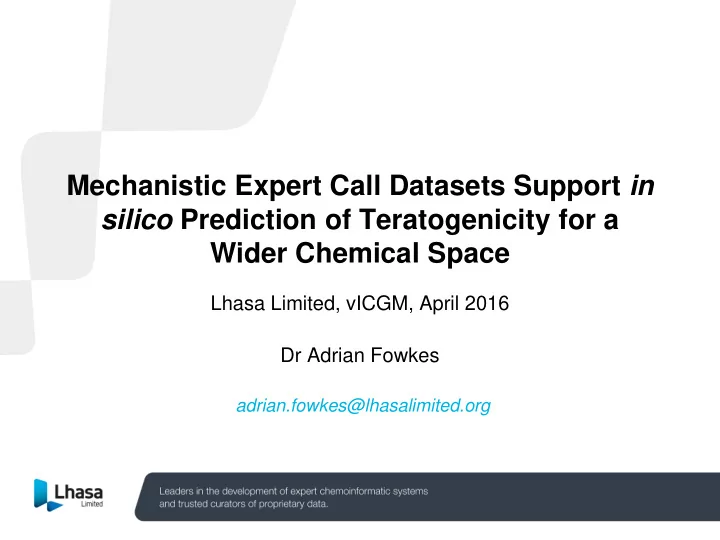

Mechanistic Expert Call Datasets Support in silico Prediction of Teratogenicity for a Wider Chemical Space Lhasa Limited, vICGM, April 2016 Dr Adrian Fowkes adrian.fowkes@lhasalimited.org
Outline 1. Teratogenicity alerts in Derek Nexus 2. Workflow for implementing new molecular initiating event (MIE)- based alerts for Derek Nexus 3. Performance of MIE specific custom knowledge bases (KBs) 4. Conclusions & Future Work
Teratogenicity endpoint in Derek Nexus (2014) Query e.g. Plausible: compounds Alerts based on Teratogenicity publically available Query compound Alert teratogenicity data will cause teratogenicity No data publically available to support No Alert ‘Nothing to report’ a teratogenicity prediction Teratogenicity alerts in Derek Nexus are based on the limited in vivo toxicity data available in the public domain
Teratogenicity alerts in Derek Nexus Teratogenicity Alert Description Data Transparent predictions Examples Mode of Action Adverse outcome pathway (AOP) Molecular Key events Adverse outcome: initiating event (KEs) Teratogenicity (MIE) Use pharmacological data Additional predictions from MIEs and KEs for teratogenicity
Lhasa Reprotoxicity Workflow • Using pharmacological data ( in vitro and in vivo ) e.g. AOP for teratogenicity stemming from oestrogen receptor modulation (ERM) MIE AO KE 1) Map AOP ER binding Teratogenicity ER dependent gene modulation Public domain Curate and Structure data 2) Data target data standardise Assays/ Handling (e.g. ChEMBL) structures bioactivities Apply expert- Assign mode Apply conservative 3) Knowledge derived of action to approach to overall thresholds for Enrichment assays activity/chemical bioactivities Lhasa mechanistic expert activity call dataset (LMEAD)
Lhasa Mechanistic Expert Call Datasets
Lhasa Reprotoxicity Workflow • Use of pharmacological data ( in vitro and in vivo ) e.g. AOP for teratogenicity stemming from oestrogen receptor modulation (ERM) MIE AO KE 1) Map AOP ER binding Teratogenicity ER dependent gene modulation Public domain Curate and Structure data 2) Data target data standardise Assays/ Handling (e.g. ChEMBL) structures bioactivities Apply expert- Assign mode Apply conservative 3) Knowledge derived of action to approach to overall thresholds for Enrichment assays activity/chemical bioactivities Clustering Lhasa mechanistic MIE Structural 4) Knowledge and expert expert activity call alerts in mining evaluation dataset (LMEAD) Derek Nexus
MIEs relevant to teratogenicity • Datasets and expert models created for three MIEs: • Oestrogen receptor modulation (ERM) • Androgen receptor modulation (ARM) • 5alpha-Reductase inhibition (5aRI) Table 1. Analysis of the Lhasa mechanistic expert activity calls datasets. LMEAD Number of Active substances Response type known Data points verified substances (Equivocals removed) for active substances ERM 6952 55% 51% 46% ARM 4849 62% 68% 64% 5aRI 1261 83% NA 66% Knowledge injection by Lhasa scientists has led to the production of purposeful and high quality training sets
MIEs relevant to teratogenicity • Datasets and expert models created for three MIEs: • Oestrogen receptor modulation (ERM) • Androgen receptor modulation (ARM) • 5alpha-Reductase inhibition (5aRI) Table 2. Composition of the three MIE specific Derek Nexus custom knowledge bases. Endpoint Alerts in Number of existing Number of new MIE Potential new Custom KB teratogenicity alerts alerts MIE alerts ERM 48 3 9 36 ARM 23 2 7 14 5aRI 24 1 16 7 New MIE-based alerts allow for additional teratogenicity predictions
Performance of each MIE custom KB KB1: 100 ERM relevant KB2: teratogenicity 80 ERM custom alerts only: KB 767, 772, 781 KB1_ERM 60 KB2_ERM (%) KB1_ARM 40 KB2_ARM KB1_5aRI 20 KB2_5aRI 0 Balanced Sensitivity Specificity Positive Negative Accuracy Predictivity Predicitivty Performance of each custom knowledge base (KB2) created for the 3 MIEs compared to the relevant Derek Nexus teratogenicity alerts (KB1 - 2014 certified KB).
Transparent reasoning in Derek Nexus
Conclusions • Successfully used pharmacological data to support teratogenicity predictions for a wider chemical space using three different MIEs. • MIE-based alerts for teratogenicity are now present in the 2016 Derek Nexus release: • 9 alerts for oestrogen receptor modulation • 16 alerts for 5alpha-reductase inhibition • Reasoning rules have facilitated tailored predictions for both MIE endpoints and teratogenicity. In addition, they explain clearly the relationship between MIE and toxicity while maintaining the much needed transparency.
Future Work • Validate the individual MIE custom KBs using data from additional sources • Assess the performance of the custom KBs against datasets from Lhasa Limited members • Investigate other MIEs relevant to teratogenicity, e.g. • Glucocorticoid receptor modulation • Aromatase inhibition
Acknowledgements • Lead Scientist • Bashir Surfraz • Past and present team members • Alex Cayley • Jeffrey Plante • Alun Myden • Emma Hill • The Knowledge Team
Questions?
Work in progress disclaimer This document is intended to outline our general product direction and is for information purposes only, and may not be incorporated into any contract. It is not a commitment to deliver any material, code, or functionality, and should not be relied upon. The development, release, and timing of any features or functionality described for Lhasa Limited’s products remains at the sole discretion of Lhasa Limited. 17
Recommend
More recommend